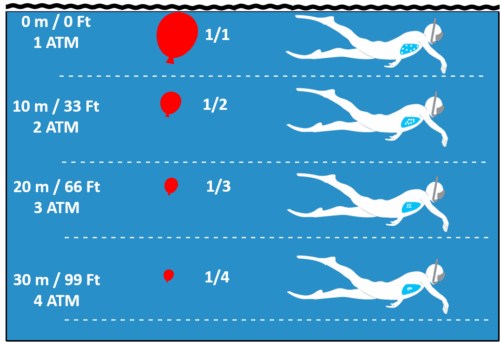Open Water Dive Theory Section 1: A Solid Foundation for Your First Dive
Welcome to the first in-depth step on your journey to conquer the ocean! If you’ve read our comprehensive guide to Open Water Dive Theory, you know that Section 1 is the very foundation of all your diving knowledge.
In this article, Amadive will help you “decode” the core concepts: how pressure works, why equalization is so critical, and get you acquainted with your essential underwater companions. Let’s begin!

1. Pressure – The Invisible Companion
As you descend into the water, you’ll feel a gentle squeezing sensation on your body. That’s pressure.
- The Concept: Water is much heavier than air. For every 10 meters (33 feet) you descend, the pressure increases by 1 atmosphere (atm).
- At the surface: The pressure is 1 atm.
- At 10 meters deep: The pressure is 2 atm (1 from the air + 1 from the water).
- At 20 meters deep: The pressure is 3 atm.
- Effects on Volume and Density: According to Boyle’s Law, as pressure increases, the volume of air decreases, and its density increases. For example, a balloon taken to a depth of 10 meters will be half its original size. This explains why you consume the air in your tank faster at greater depths.
2. Your Body and Its Air Spaces
Our bodies have several air spaces that are directly affected by pressure. Understanding and managing them is the key to a comfortable dive.
- Main Air Spaces: Middle ears, sinuses, mask, and lungs.
- “Squeeze”: As you descend, the increasing external pressure pushes on these air spaces. If you don’t equalize the pressure inside, you will feel pain or discomfort.
- The Equalization Technique: This is a crucial skill you must perform.
- Gently pinch your nostrils closed.
- Exhale gently through your nose (as if blowing your nose).
- You should hear a gentle “pop” or “click”—that’s the sound of the pressure equalizing.
- Pro Tip: Equalize early and often throughout your descent. Don’t wait until you feel pain.
3. The Golden Rule of Scuba Diving: NEVER Hold Your Breath
This is the most important safety rule in diving, with no exceptions.
- Why? As you ascend, the external pressure decreases, and the air in your lungs expands. If you hold your breath, the expanding air becomes trapped and has no way to escape, which can cause a serious lung over-expansion injury.
- What to do: Always breathe slowly, deeply, and continuously. Let your breathing become a natural, uninterrupted rhythm while you are underwater.
4. Getting to Know Your Scuba Gear
Your scuba equipment is your life support system. In Section 1, we learn the basic function of each part:
- Tank/Cylinder: Contains compressed air for you to breathe.
- Regulator: The “brain” of the system. It takes the high-pressure air from the tank and reduces it to a pressure you can comfortably breathe.
- Buoyancy Control Device (BCD): Like a jacket you wear, you can inflate or deflate it to help you float at the surface, hover weightlessly at a certain depth, or descend.
- Information System: This includes the Submersible Pressure Gauge (SPG) to monitor your air supply, a depth gauge, and a compass.
Conclusion for Section 1
Congratulations on completing the most fundamental knowledge! A clear understanding of pressure, equalization, breathing rules, and equipment functions will make you feel much more confident as you head into your in-water practice sessions.
Now that you’ve mastered the “rules of the game,” you’re ready to learn about the practical skills and safety procedures.
